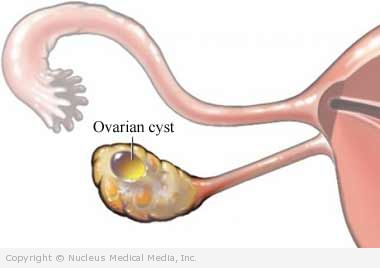Polycystic Ovary Syndrome
(PCOS; Stein Leventhal Syndrome; Polyfollicular Ovarian Appearance; Hyperandrogenic Anovulation; Polycystic Ovarian Disease; PCO; PCOD)
Polycystic Ovary Syndrome – Definition
Polycystic ovary syndrome (PCOS) is a chronic endocrine disorder in women. Characteristics of PCOS are:
- High levels of male hormones (androgens)
- Infertility
- Obesity
- Insulin resistance
- Hair growth on face and body
- Anovulation — when the ovaries mature few or no eggs
Ovaries make follicles that hold eggs. With PCOS, the ovaries make the follicles, but the eggs do not mature or leave the ovary. The immature follicles can turn into fluid-filled sacs called cysts. Most women with PCOS have cysts. But women with ovarian cysts do not necessarily have PCOS.
Polycystic Ovary Syndrome – Causes
The cause is unknown. Genes may play a role. The problem is related to insulin resistance that creates high levels of insulin. These high insulin levels cause too much androgen from the ovaries. This prevents ovulation and leads to enlarged, polycystic ovaries.
Polycystic Ovary Syndrome – Risk Factors
These factors increase your chance of developing PCOS. Tell your doctor if you have any of these risk factors:
- Obesity
- Sedentary lifestyle
- Family members with PCOS
- Irregular menstrual cycles
- Age at onset: 15-30 years old
Polycystic Ovary Syndrome – Symptoms
If you have any of these symptoms do not assume it is due to PCOS. These symptoms may be caused by other conditions. Tell your doctor if you have any of these:
- Irregular menstrual periods or no menstrual period ( amenorrhea)
- Infertility
- Undesired hair growth on face and body
- Weight gain
- Obesity
- Acne
- Dark patches of skin on neck, groin, and arm pit
Rarely, symptoms include:
- Deep voice
- Temporal (right or left side of forehead) balding
Women with PCOS are also at increased risk for:
- Type 2 diabetes — due to insulin resistance (also glucose intolerance and prediabetes)
- Hyperlipidemia — increased fat and cholesterol in the blood
- Overgrowth and thickening of uterine lining — endometrial hyperplasia, a precancerous condition
- Endometrial cancer
- High blood pressure
- Heart disease
- Metabolic syndrome — a combination of obesity, insulin resistance, high blood pressure, dyslipidemia, and increased tendency to blood clotting and inflammatory states
Polycystic Ovary Syndrome – Diagnosis
The doctor will ask about your symptoms and medical history. She will ask questions about your periods and when they first started. The doctor will also perform a physical exam, including a pelvic exam and a measurement of your body mass.
The doctor will order a range of blood tests, such as:
- Blood tests
- Androgen – free testosterone or total testosterone
- Dehydroepiandrosterone sulfate (DHEAS)
- 17-hydroxyprogesterone
- Prolactin and thyroid function tests are often done
- Fasting blood sugar level and fasting insulin are recommended
- Fasting lipid profile is recommended
A pelvic ultrasound may also be done to look for multiple cysts on the ovaries.
Polycystic Ovary Syndrome – Treatment
Treatment differs according to whether you want to conceive or not. Treatment targets the underlying insulin resistance that accompanies PCOS diagnosis.
Treatment includes:
- Managing symptoms
- Weight loss if overweight, nutrition consultation
- Exercise
- Insulin resistance, glucose intolerance, and prediabetes management
- Use of oral agents such as: Metformin, Glucophage, Actos, Avandia
- Oral contraceptive
- Inducing ovulation (if you wish to get pregnant)
- Metformin with or without Clomiphene citrate
- Advanced reproductive technologies
- Preventing complications
- Anti-androgenic medicines for blocking future hirsutism (unwanted hair growth)
Lifestyle Measures
To lower cholesterol levels and reduce the risk of type 2 diabetes, high blood pressure, and heart disease:
- Get regular screenings for diabetes, high blood cholesterol, and fat levels.
- Exercise regularly.
- Eat a low-fat diet.
- Maintain a healthy weight.
Hormonal Therapy
Birth control pills regulate periods. Also, by causing the uterine lining to shed regularly, they reduce the risk of overgrowth or cancer. They also control abnormal hair growth and acne by supressing androgen. Other hormones (called progestins) may also be used to regulate menstruation. They can be used monthly or intermittently. Fertility drugs may be given instead to stimulate ovulation in women who want to become pregnant.
Polycystic Ovary Syndrome – Prevention
PCOS can be prevented by recognizing those at risk during their teen years—due to family history, irregular periods, and obesity. It may be possible to avoid PCOS if the causes of obesity are addressed successfully and you follow a special diet and exercises.

